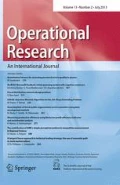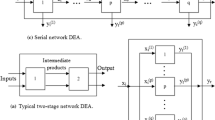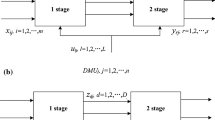Abstract
Efficiency measurement has been an essential topic in banking research. Many studies have used the data envelopment analysis approach as an effective tool for the efficiency measurement of bank branches. Recently, the Network (NDEA) method has been introduced, which involves internal processes and intermediate factors in the efficiency measurement. A few studies have used this method for the efficiency measurement of bank branches; they have considered two processes in branches and used two-stage models. In this study, we will use a more general approach and a more complete network structure consisting of three processes, including the deposit attraction process, deposit allocation process and banking services provision process. Since we want to obtain efficient targets, an envelopment form of the NDEA model had to be used. Therefore, a slack-based NDEA model, as introduced by Tone and Tsutsui (SBM-NDEA), was nominated to support its mathematical model. But according to the new categorization of the efficiency measurement factors introduced in this paper, and also regarding some previous reviews on SBM-NDEA model, the model will be modified to include the desired properties. Finally, by applying the modified model, branches efficiency scores and also efficient targets will be obtained.


Similar content being viewed by others
Notes
Common set of weights.
References
Banker RD, Charnes A, Cooper WW (1984) Some models for estimating technical and scale inefficiencies in data envelopment analysis. Manage Sci 30:1078–1092
Berger AN, Humphrey DB (1997) Efficiency of financial institutions: international survey and directions for future research. Eur J Oper Res 98:175–212
Charnes A, Cooper WW, Rhodes E (1978) Measuring the efficiency of decision making units. Eur J Oper Res 2:429–444
Chen Y, Cook WD, Kao C, Zhu J (2013) Network DEA pitfalls: divisional efficiency and frontier projection under general network structures. Eur J Oper Res 226:507–515
Cook WD, Liang L, Zhu J (2010) Measuring performance of two stage network structures by DEA: a review and future perspective. Omega 38:423–430
Färe R, Grosskopf S (1996) Intertemporal production frontiers: With dynamic DEA. Kluwer Academic, Boston
Färe R, Grosskopf S (2000) Network DEA. Socio-Econ Plan Sci 34:35–49
Fethi MD, Pasiouras F (2010) Assessing bank efficiency and performance with operational research and artificial intelligence techniques: a survey. Eur J Oper Res 204:189–198
Fukuyama H, Mirdehghan SM (2012) Identifying the efficiency status in network DEA. Eur J Oper Res 220:85–92
Giokas DI (2008) Assessing the efficiency in operations of a large Greek bank branch network adopting different economic behaviors. Econ Model 25:559–574
Halkos GE, Tzerermes NG, Kourtzidis SA (2014) A unified classification of two-stage DEA models. Surv Oper Res Manage Sci 19:1–16
Kao C (2014) Network data envelopment analysis: a review. Eur J Oper Res 239:1–16
Kao C, Hwang SN (2008) Efficiency decomposition in two-stage data envelopment analysis: an application to non-life insurance companies in Taiwan. Eur J Oper Res 185:418–429
Lin TY, Chiu SH (2013) Using independent component analysis and network DEA to improve bank performance evaluation. Econ Model 32:608–616
Matthews K (2013) Risk management and managerial efficiency in Chinese banks: a network DEA framework. Omega 41:207–215
Pastor JT, Lovell CAK, Tulkens H (2006) Evaluating the financial performance of bank branches. Ann Oper Res 145:321–337
Schaffnit C, Rosen D, Paradi JC (1997) Best practice analysis of bank branches: an application of DEA in a large Canadian bank. Eur J Oper Res 98:269–289
Tone K, Tsutsui M (2009) Network DEA: a slacks-based measure approach. Eur J Oper Res 197:243–252
Wanke P, Barros CP, Faria JR (2015) Financial distress drivers in Brazilian banks: a dynamic slacks approach. Eur J Oper Res 240:258–268
Yang C, Liu HM (2012) Managerial efficiency in Taiwan bank branches: a network DEA. Econ Model 29:450–461
Acknowledgments
The authors would like to sincerely thank the members of the R&D center of Mehr-e-Eghtesad Bank especially Mr. Mohammad Mahdi Amini and Mr. Mohammad Khedmati for their constructive contributions in this study.
Author information
Authors and Affiliations
Corresponding author
Rights and permissions
About this article
Cite this article
Boloori, F., Pourmahmoud, J. A modified SBM-NDEA approach for the efficiency measurement in bank branches. Oper Res Int J 16, 301–326 (2016). https://doi.org/10.1007/s12351-015-0201-1
Received:
Revised:
Accepted:
Published:
Issue Date:
DOI: https://doi.org/10.1007/s12351-015-0201-1




